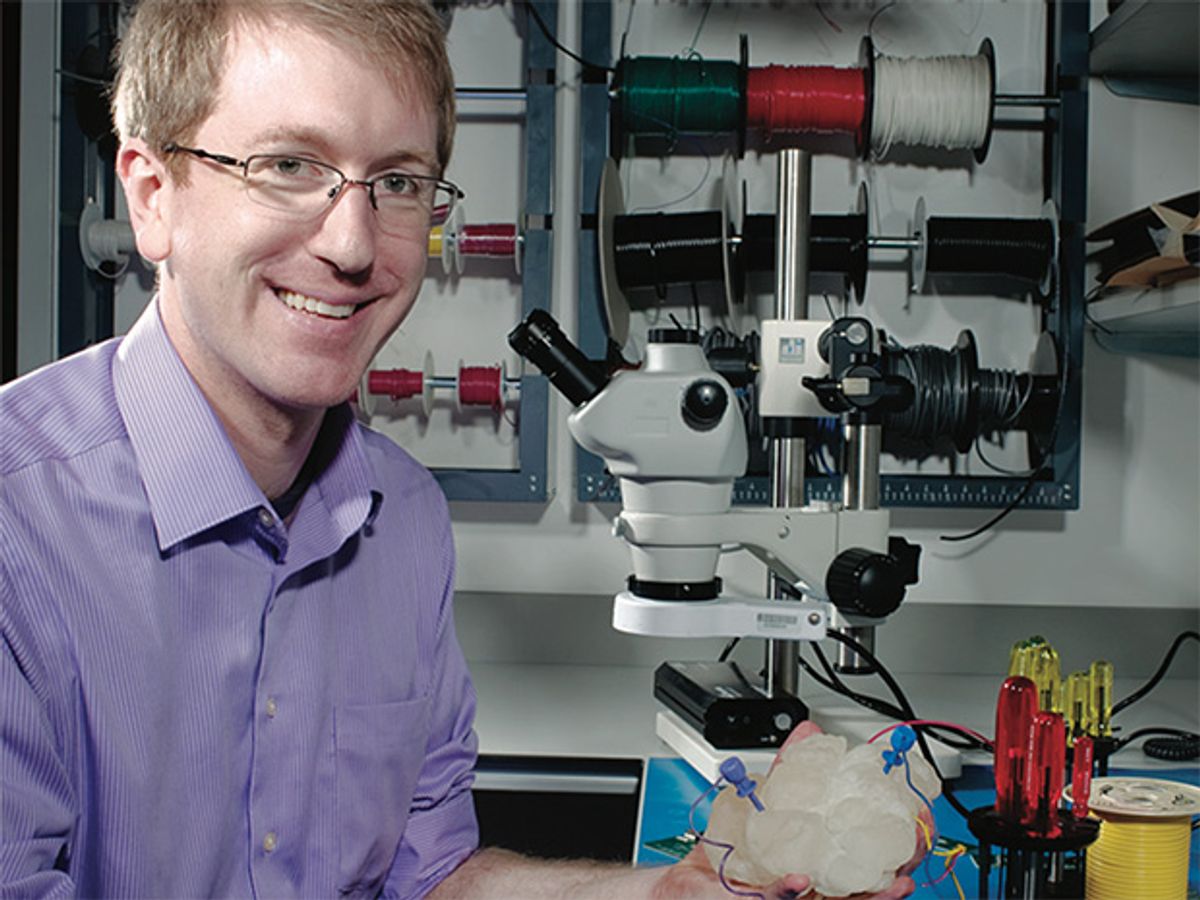Dream Jobs 2011: Insect Imagineer
Gus Lott designs virtual reality systems for bugs and rats so that we can study their brains—and ours

Gus Lott
IEEE Member
Age 31
What He Does
Builds virtual reality systems for insect and animal research.
For Whom
The Howard Hughes Medical Research Institute’s Janelia Farm
Where He Does It
Ashburn, Va.
Fun Factors
Creates novel tools that enable scientists to do groundbreaking research; can publish and talk openly about everything he does; works in a university-like environment that is free from worries about funding or making profits.
This profile is part of IEEE Spectrum’s Special Report on Dream Jobs 2011.
Gus Lott pretty much always knew he would be an electrical engineer. His dad, an EE working for the U.S. Navy, brought home tales of engineering heroism, and Lott wanted to follow in his footsteps.
“His generation of engineers made the Internet and created cellphones and communications networks,” Lott says. “It was awesome stuff.”
Like his father, he entered Auburn University, in Alabama, to major in EE, soon adding a second major in physics. “Physics was how to ask the questions, and engineering was how to answer them. Having such synergy made it easier in a lot of ways,” he says.
But in 1998, at the beginning of his third year, Lott started thinking about what he might do with all this knowledge. The big wave of electrical engineering breakthroughs seemed to have crested. He figured that instead of pushing the frontiers of technology, he’d most likely spend his career building slightly better mousetraps, designing smaller transistors, or writing abstruse algorithms for mobile phones. None of that sounded exciting. It was time to look beyond classical electrical engineering.
With Viagra and stem cells hitting the news, he decided that biology might be where his generation would make its mark. He started taking all the biology courses he could, and he asked his Biology 101 professor if he could get involved in research. The surprised professor took him on, taking advantage of Lott’s engineering background to have him create a mathematical simulation of the flagella on striped-bass sperm. In 2001, Lott entered the biophysics graduate program at Cornell University, in Ithaca, N.Y.
The biology and biochemistry classes were oddly familiar. “They were talking about signal transduction across membranes—it was just a systems analysis problem,” he says. Sometimes the vocabulary did trip him up, though. He lost points on an exam for expressing an answer in hertz instead of the “seconds to the minus one” term used by biologists. (He explained to the professor that he was using SI units and got the points restored.)
After a standard rotation through Cornell’s laboratories, Lott ended up in the neurobiology department. For one researcher’s project on understanding how flies make choices, he built a fly-scale virtual reality system, with a treadmill made out of a ping-pong ball and an optical mouse. A tethered fly would run on the ball, while the optical components would track the ball’s movement. He surrounded the system with speakers that generated enticing cricket chirps—the fly being studied uses a live cricket as a nest for its eggs. Changing the pitch of the chirp presented the fly with a choice of virtual crickets.
The Purr-fect App
In his free time, Lott created an iPhone app called Mr. Snuggles that replicates the response of a cat’s fur to petting. He modeled it after his two marmalade cats.
Lott packaged the fly system with two other tool-building projects into his Ph.D. thesis. And he made an important discovery: He really didn’t want to do research. “I liked building the glasses that the researcher looks through the world with,” he says. But he was worried. If not research, what would he be able to do? “I felt like I was mediocre at a lot of things,” Lott says. “I didn’t want to do neuroscience. I wasn’t an amazing embedded-systems programmer. I wasn’t awesome at signal processing. I was a generalist across neuroscience and engineering.”
It looked to him as if he was going to have to walk away from biology and get an entry-level EE job after all. But shortly before his May 2007 graduation, he got lucky. A professor told him about a recent guest lecture on fruit flies. The lecturer had mentioned a place in Virginia called Janelia Farm that was looking to hire a few engineers.
“I had no idea that Janelia even existed,” Lott recalls. He Googled it and found a dream come true.
Janelia Farm, established in 2006, is a research laboratory dedicated to understanding human consciousness. That goal may take 100 years, so for now the lab is decoding the brains of simpler animals, such as those of flies and lizards. As a branch of the Howard Hughes Medical Institute, it’s well funded, with an annual budget of about US $80 million and 300 or so researchers. The facility is housed in a $500 million light-filled glass building, tucked behind rolling hills near the banks of the Potomac River.
Lott quickly sent his résumé. Within days he heard from Gerald Rubin, the center’s director, who invited him to come for an interview. In less than a week, Lott was on a plane to Virginia, the ink on his doctorate practically still wet—he had run around that morning to collect the final signatures.
At the interview, he confessed that he didn’t want to do research; he wanted to build tools. Janelia already had two machinists and a microscopy specialist doing essentially that, but Rubin wasn’t opposed to adding an engineer. “They wrote the position for me,” Lott says, “and called it neurobiological instrumentation engineer. I went from thinking I was going to have to throw my Ph.D. work out the window to getting a job that was a perfect fit because it was created for me.”
Lott’s shop at Janelia is in the basement. While the building above is an architect’s dream, Lott’s lair is anything but. The unfinished concrete floor is scratched and splashed with paint; uncovered ducts and pipes snake across the ceiling. But he likes it this way.
“I feel like Q in the James Bond movies. He’s down there in the basement of MI6, and all the agents come to him for crazy technology to carry out their missions,” he says.
Lott’s first gizmo was an automatic fly swatter that was used to study fear in flies. These days, he’s working on a smart maze for rats full of virtual reality effects, such as a TV screen that flashes an image of a cat.
But most of his work so far has been with the Fly Olympiad project, which seeks to understand the function of every cell in a fruit fly’s brain. Researchers have bred fruit flies with different cells turned off; they then try to determine what each cell controls. To monitor the flies’ reactions to patterns of light, for instance, he designed special displays. A standard video display with a refresh rate of 60 hertz looks fine to the human eye, but fruit flies process images much faster—they would perceive a disturbing flicker. So Lott built a fruit fly TV capable of 200 Hz. It displays only patterns of colored light, but flies respond dramatically, stampeding in different directions in response to different patterns.
Analyzing the flies’ mating calls was another challenge. Given that the sounds are very faint, and individual flies are not inclined to step right up to a microphone, he looked instead at their wings, which the flies flap to create sound. By videoing the shadows of the flapping wings and converting those images into sine waves, he was able to generate an electronic duplicate of the original sound. So far, researchers have run more than half a million flies through Lott’s devices.
Lott may not be at Janelia Farm forever—he’d eventually like to work on augmented reality systems for humans, not just flies and rats. But for now, he says, he’s about as happy as a kid with a stack of Oreos in front of him. “For me, the neuroscience research part is the cookie part of the Oreo; the engineering part is the cream. And I get all the cream.”
An abridged version of this article appeared in print as “Insect Imagineer.”
To Probe Further
For more articles and special features, go to Dream Jobs 2011.




